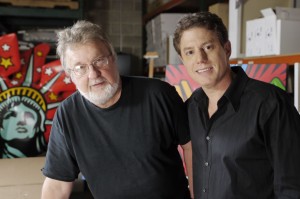Usually, I’m shooting nice things… like attractive people eating food while smiling. This project was completely different.
John Brabender (BrabenderCox) is one of the country’s top political media consultants. For over 10 years, he and I have worked together on many successful TV campaigns. John rarely thinks anywhere near the box, much less inside it.
John gave us less than a week to put together this project. Fortunately, I remembered scouting an old abandoned manufacturing building in Pittsburgh for a previous TV campaign. My producer and production coordinator, Judy Gurchak and I re-scouted the location and it was still available.
I set up most of the shots to take advantage of a wall of windows that lined the North side of the building. This became my primary light source, supplemented with 1200 and 2500 watt HMI’s. We used smoke machines to add atmosphere and distance to the scenes.
Growing up in Florida, I hate shooting in freezing cold weather. For the entire shoot day, our set temperature was less than 50ºF. We couldn’t use heaters because they quickly dissipated the smoke. Our shoot day was overcast and snowy, so we knew we would loose useable window light by 4:30PM.
I used a motorized, 7′ slider for the marching feet scenes and all ground level camera angles. This slider can smoothly move 25 pounds of camera.
I photographed everything with a RED Epic M using the standard set of RED primes including the 300mm telephoto. Every scene (except the fall) was shot at 30fps for playback at 23.98.
Thad Christian at Pittsburgh’s Phenomenom Post did an amazing job editing and grading the 90 second spot in less than 2 days including numerous effect shots. Michael Goodis handled original sound design. Steve Parys worked his butt off as my assistant director. Without the talents of gaffer, Ted Wiegand and scenic designer, Rich Schutte none of this would have been possible in such a short amount of time.
Burton Morris has created major works for CocaCola, The Academy Awards, Heinz, the Olympics, Absolut Vodka and hundreds of other corporations. Although he’s an internationally famous artist, Burton Morris’ is also one of the nicest guys you’ll ever meet.
He just completed a fun project for Eat ‘n Park Restaurants. Burton created his own original art to celebrate the 25th anniversary of “Smiley,” Eat ‘n Park’s corporate cookie icon. This summer, Burton Morris’ original artwork will adorn t-shirts, coffee mugs and other items that are sold in Eat ‘n Park’s chain of over 80 restaurants.
Sorry, I can’t reveal Burton’s original “Smiley” artwork, ’till it’s unveiled in June!… stay tuned!


